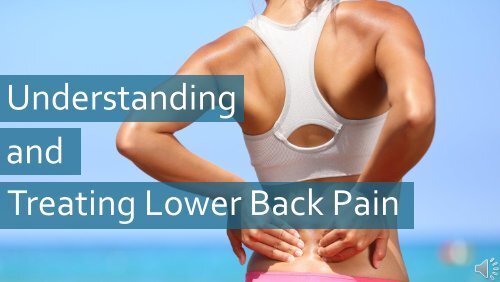Lower Back Pain Understanding
Strains and injuries are very likely to occur as this is the area in your back that endures a lot of twisting, tension and weight over the years.
Strains and injuries are very likely to occur as this is the area in your back that endures a lot of twisting, tension and weight over the years.
You also want an ePaper? Increase the reach of your titles
YUMPU automatically turns print PDFs into web optimized ePapers that Google loves.
<strong>Understanding</strong><br />
and<br />
Treating <strong>Lower</strong> <strong>Back</strong> <strong>Pain</strong>
<strong>Understanding</strong><br />
and<br />
Treating <strong>Lower</strong> <strong>Back</strong> <strong>Pain</strong>
<strong>Lower</strong> back pain usually takes place when the<br />
muscles in this area become weak or injured.
The most common cause is muscle strain, but there<br />
are other possible culprits as well such as
Falling
Sudden Movement
Prolonged sitting
Obesity
You have large and complex groups<br />
of muscles that work together to<br />
help support your spine and keep<br />
your body upright.<br />
These muscles also allow you to<br />
twist, bend and move your body in<br />
many different directions.
Therefore, these muscles<br />
are vital for a proper<br />
posture and mobility.
The three groups of muscles located in your lower back are the<br />
flexor, extensor and iliopsoas muscles, and below are their<br />
corresponding purpose.
Flexor Muscles<br />
As the name suggests,<br />
flexor muscles allow you<br />
to bend forward, flex, lift<br />
and arch your back.<br />
These muscles are<br />
attached to the<br />
abdominal walls and to<br />
the front of the spine.
Extensor Muscles<br />
The extensor muscles are<br />
the largest muscles in<br />
your lower back. They are<br />
composed of many<br />
smaller muscle groups<br />
important in<br />
straightening, bending<br />
and erecting your spine
Extensor Muscles<br />
Apart from this, the<br />
extensor muscles assist<br />
you with spine rotations<br />
and aid you in standing<br />
and lifting objects.
Iliopsoas Muscles<br />
The iliopsoas muscles help<br />
the spine rotate and the<br />
pelvis bend and flex. These<br />
muscles also help maintain<br />
balance and correct<br />
posture while standing up.
Iliopsoas Muscles<br />
The iliopsoas are located<br />
on each side of the lower<br />
back, attached to the<br />
vertebrae of the spine,<br />
and inside the pelvis.
What are the causes of lower back pain?
There are many underlying causes of lower back pain.<br />
Strains and injuries are very likely to occur as this is the area in your<br />
back that endures a lot of twisting, tension and weight over the<br />
years.
If you do not maintain healthy and strong muscles, you are exposing<br />
yourself to the risk of injuries.
Here are other common causes of lower back<br />
pain.
Lifting Heavy Objects<br />
When your muscles aren’t strong enough and you lift heavy objects<br />
incorrectly, this can lead to muscle strains.
To avoid this type of incident from happening to you, you have to<br />
learn the proper techniques for lifting heavy objects, such as<br />
bending your knees and not rounding your back.
Playing Sports<br />
Sports such as football, soccer, basketball or hockey are some of the<br />
physical activities that can cause the most wear and tear to your<br />
back muscles.
This is why professional athletes need to undergo strength training –<br />
it helps them withstand the constant physical stress on their back<br />
caused by playing sports.
A Fall or A Recent Trauma<br />
In the event of a trauma or accident, there are instances wherein<br />
pain does not manifest itself right away. It is common that the<br />
aftermath of a recent trauma can be felt days after the accident.
If you have been involved with a certain casualty lately and the pain<br />
has just started to kick in, see a doctor right away.
Poor Posture<br />
Poor posture, whether you are standing, sitting or sleeping, forces<br />
your muscles to work extra hard just to keep your body upright.
This places excess tension and stress on your lower back muscles<br />
and can cause pain in the long term.
Obesity or Overweightness<br />
Being obese or overweight also has dire consequences on your<br />
back health, not just your general health.
Excess weight puts extra pressure not just on your muscles but on<br />
your spine as well.
This is the reason why many overweight people suffer from poor<br />
posture. And when posture is poor, it also puts a lot of stress on<br />
your back.
How can I fix my back pain issues?
Most back problems resolve on their own<br />
overtime after treatment is applied. Typically,<br />
it takes more or less two weeks for your<br />
condition to improve.<br />
But to help speed up your recovery, here are<br />
other treatments you can use to remedy<br />
lower back pain.
Take muscle relaxants prescribed<br />
by your physician
Take anti-inflammatory supplements<br />
to reduce pain and swelling
Get a massage to promote blood flow<br />
and speed up recovery
Practice some strength exercises and<br />
stretching to tone and loosen up the muscles
Apply warm and cold compresses to reduce<br />
swelling
If you are overweight, try to lose the extra<br />
pounds
With proper treatment and pain resolution techniques,<br />
you can alleviate back pain in just two weeks
But if the pain has not subsided after a month, it is best to see<br />
your doctor or a specialist to determine whether or not there<br />
are other underlying causes that you should be worried<br />
about.






